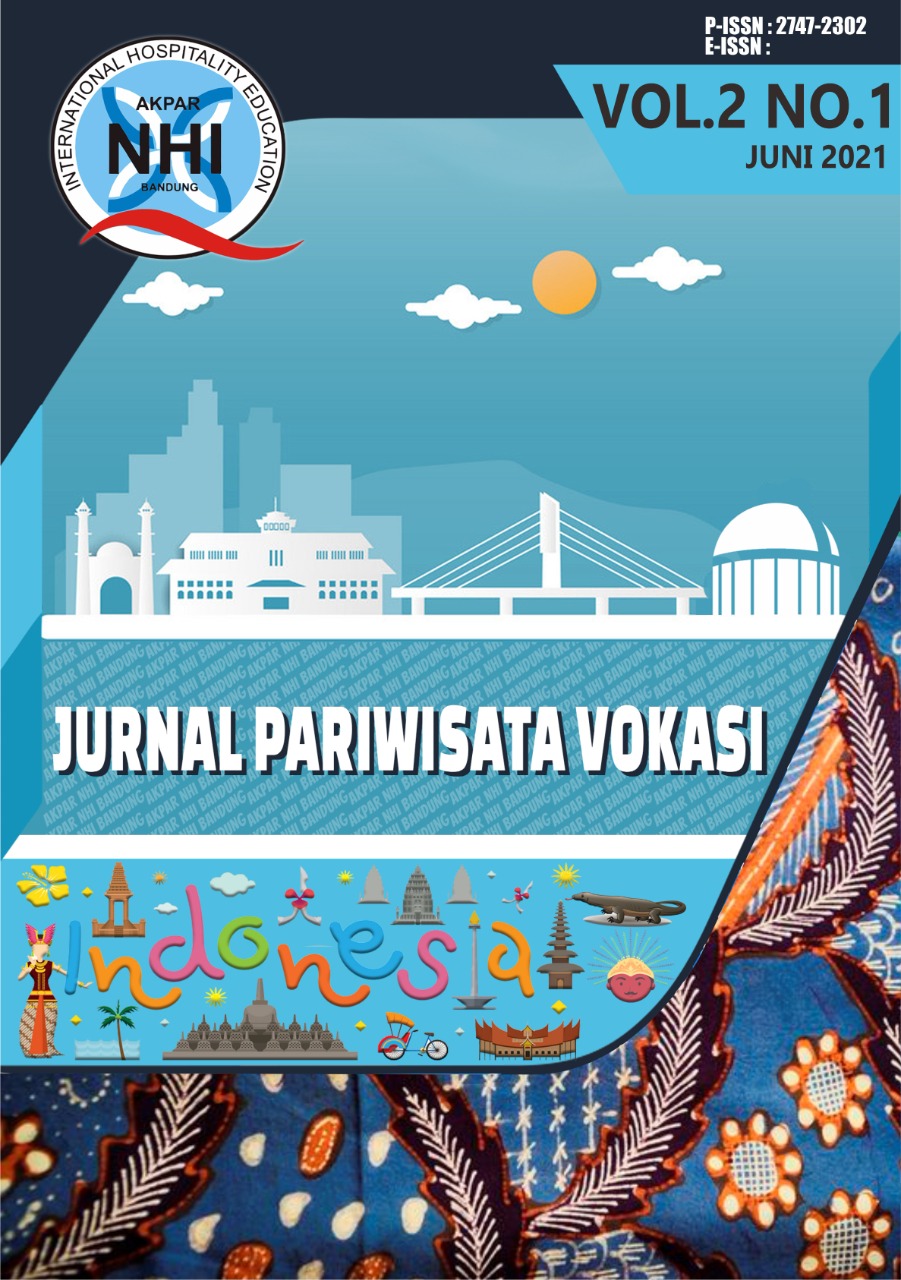PEMBUATAN CARICA FRUIT LEATHER DENGAN SUHU PENGERINGAN YANG BERBEDA
Abstract
This study aims to determine the right temperature in the manufacture of Carica fruit leather which will produce the best organoleptic test results and is favored by panelists and also as a food diversification made from Carica fruit can minimize the value of post-harvest loss by processing it into fruit leather can increase the economic value of the Carica fruit and also determine the acceptance of Carica fruit leather products to tourists who visit the tourist area of Dieng and the citizens of Dieng. The collection method used is the experimental method. Data collection techniques were carried out using product experiments, distributing questionnaires, and observing. While the data analysis technique using a hedonic scale. Based on the results of the study, it can be seen that professional panelists prefer Carica fruit leather with a temperature of 70oC. Similar to the professional panelists, the consumer panelists for Carica fruit leather with a temperature of 70oC were superior with the criteria of Carica fruit aroma, sweet and slightly sour taste, slightly brownish yellow color, and slightly rough, thin & elastic texture; then the selling price that the author gets with a profit of Rp.212,050, - is Rp.899.540,-per 100 pcs, then the selling price of Carica fruit leather per pc unit is Rp. 8.955,-; and acceptance of Carica fruit leather products are included in the "Accepted" category. Problems in research: 1) What is the taste of fruit leather made from Carica fruit with different drying temperatures? 2) How to calculate the selling price of fruit leather made from Carica fruit with different drying temperatures? 3) How is the potential for consumer acceptance of fruit leather made from Carica fruit with different drying temperatures?. Suggestions given for problem-solving are: 1) Carica fruit leather product packaging can be improved again to make it more attractive, efficient and also increase its selling value; 2) The shape of the Carica fruit leather product can still be reduced to make it easier to eat; 3) If viewed from the aspect of the cost of Carica fruit leather products, it is still too cheap, so it can still be developed in terms of shape, packaging, and others.
References
Dewi, Rizki kharina. 2017. Analisis Rantai Nilai Komoditas Buah Carica Di Kecamatan Kejajar Kabupaten Wonosobo. Skripsi Jurusan Ekonomika dan Bisnis. Universirtas Diponegoro
Dinas Koperasi dan UMKM. (2016). Produksi Carica di Kabupaten Wonosobo Tahun 2012-2016. Wonosobo: Dinas Koperasi dan UMKM Kabupaten Wonosobo
Dinas Pertanian dan Perikanan. (2019). Luas Areal dan Produksi Tanaman Carica di Kabupaten Wonosobo Tahun 2016-2018 Dalam Triwulanan. Wonosobo: Dinas Pertanian dan Perikanan Kabupaten Wonosobo.
Handayani, Fitri. 2014. Karakteristik Pengeringan Fruit Leather Buah Jambu Biji(Psidium Guava) Menggunakan Vacuum Dryer. Skripsi Jurusan Teknologi Pangan Dan Argo Industri. Universitas Mataram.
Hendrasty, Hj. Henny Krissetiana, Ir., M.P. 2013. Bahan Produk Bakery. Yogyakarta: Graha Ilmu.
Karyantina, M., Linda K., dan Agus, S.W. 2014. Kajian Karakteristik Fruit Leather Dengan Variasi Jenis Pisang (Musa paradisiaca) dan Suhu Pengeringan. Skripsi. Fakultas Teknologi dan Industri Pangan Universitas Slamet Riyadi.
Lamadlauw, Fanny Noviany. Dan Arief, Abd. Rahman. 2004. Pastry and Bakery Production. Yogyakarta: Graha Ilmu.
Mudrikah, Alfiah. 2017. Strategi Pengembnagan Usaha Industri Kecil Olahan Carica (Studi Kasus Pada UKM Gemilang Di Kabupaten Wonosobo). Skripsi Jurusan Pendidikan Ekonomi Fakultas Ekonomi. Universitas Negeri Semarang.
Nadeak, S.M.R dan D. Susanti. 2012. Variasi Temperatur dan Waktu Tahan Kalsinasi Terhadap Unjuk Kerja Semikonduktor TiO2 sebagai (DSSC) dengan Dye dari Ekstrak Buah Naga Merah. Jurnal Teknik ITS 1: 81-86.
Rini, Haris Puspita. 2011. Strategi Pengembangan Industri Kecil Carica Untuk Meningkatkan Pendapatan Pengrajin Di Kabupaten Wonosobo Tahun 2010. Skripsi Jurusan Keguruan Dan Ilmu Pendidik. Universitas Sebelas Maret. Surakarta.
Rosalina, Yessy. 2013. Studi Pengolahan Fruit Leather Mangga Varietas Bengkulu (Mangifera Indica L.) . Jurnal Teknologi Pertanian. Gakultas Pertanian. Universitas Bengkulu.
Safitri, A.A. 2012. Studi Pembuatan Fruit Leather Mangga-Rosella. Skripsi. Jurusan Teknologi Pertanian. Fakultas Pertanian. Universitas Hasanuddin. Makassar.
Standar Nasional Indonesia. 1996. Manisan kering buah-buahan No 01-1718. Badan Standar Nasional (BSN). Jakarta.
Sugiyono. 2013. Metode Penelitian Pendidikan Pendekatan Kuantitatif, Kualitatif, dan R&D. Bandung: Alfabeta.
Umami, M.Rizal. 2018. Eksperimen Produk Dodol Pepaya (Carica Papaya L.) Melalui Pengolahan Preservatif Guna Meningkatkan Umur Simpan. Skripsi Jurusan Teknologi Argo-industri. Politeknik Negeri Jember.
Downloads
Published
How to Cite
Issue
Section
License
Copyright (c) 2021 Akmal Sugiyarto

This work is licensed under a Creative Commons Attribution-ShareAlike 4.0 International License.






